Transit First Mobility Policies and Planning Paradigms
(Old streetcar from Milan, Italy on the Market Street Railway in San Francisco).
DC1974 writes in response to an earlier entry:
As for parking, SF has practically eliminated it. Its called Transit First. Even new condos are not built with parking. Oakland, SF and Berkeley don't even use buses for school children. Or provide parking for the older students. Everyone uses transit. Or walks to the neighborhood school.
So I had to look up Transit First. This is discussed in the piece "Transportation Principles for San Francisco," from SPUR, the San Francisco Planning and Urban Research Association. From the webpage:
Transportation in San Francisco is unlike other western cities. We have inherited from the 19th century a compact street grid and the highest densities west of Chicago. Our city grew up around the pedestrian and the trolley; additions to the city must find ways to build on our tradition of walkability and transit-access.
On the other hand, the city is changing, and if our transportation system doesn't evolve to support these changes, our dynamic economy and our quality of life will be choked off by the lack of access. We are increasingly concerned that San Francisco's investment in its transportation infrastructure has not kept pace with the growth in jobs and residents. More people live and work here, but the transportation system is being taken for granted.
SPUR proposed that San Francisco adopt a "transit-first" policy as part of its 1973 report, "Building A New Muni." This policy, while never fully implemented, still provides the basic framework of how to grow: we need to increase mobility by investing in the capacity of our transit system.
Were it not for the transit-first policy, the city would have followed the path of so many other American cities, widening roads, narrowing sidewalks, demolishing downtown buildings and then filling the spaces with parking garages. We would have destroyed the very density and walkability that makes this city different from the rest of the country, that creates the high economic values of downtown, and that provides the quality of life we enjoy.
But we cannot rest on our laurels. In the 25 years since we first proposed a transit-first policy, transportation planners have learned a lot about how a well-run urban transportation system might work....
Nearly everyone in San Francisco claims to support the transit-first policy. We thought it would be useful to spell out what such a policy means. We understand the transit-first policy as a directive to promote mobility by not just collective public transit, but by all alternatives to single occupancy vehicles.
______
This reminds me of Portland's Downtown planning principles, laid out in the early 1970s, which are also heavily transit-centric:
The Downtown plan, adopted in 1972, was intended to maintain and strengthen downtown's central role in the city by reinforcing its mix of uses--including office, retail, cultural, governmental and residential. The major concepts included:
1. Creating a North-South spine of high density offices served by public transit. The (bus) Transit Malls on SW 5th and 6th Avenues, completed in 1978, provides this spine and supported private office developments.
2. Creation of an East-West retail spine along Morrison Street that would lead the city back to the river. The MAX light rail line and rebuilt streets on Morrison and Yamhill implement that concept. Waterfront Park, which replaced an expressway, provides a riverfront destination.
 Pioneer Courthouse Square North, MAX Blue Line, Portland, Oregon. (Note the Nordstrom's.) Photo by Adam J. Benjamin.
Pioneer Courthouse Square North, MAX Blue Line, Portland, Oregon. (Note the Nordstrom's.) Photo by Adam J. Benjamin.3. Recognition and support for the subdistricts in downtown. The Skidmore and Yamhill Historic Districts are two premier examples of those subdistricts and zoning regulations were modified to protect them and funds were invested by the public and private sectors for rehabilitation.
4. Emphasis on transit and alternative modes for downtown access and limitations on parking. The plan prohibited new parking unless associated with new development and it prohibited the demolition of historic buildings for parking lots.
5. Design regulations to promote active street level storefronts--with retail space, public lobbies, and other pedestrian features typical of historic commercial buildings.
6. Policies to maintain the historic, fine-grained street grid and blocs. Vacating streets to form larger blocks and skybridges are rare in downtown. This helps to maintain an active street life.
7. Policies and programs to protect and promote fragile uses like housing, retail and hotels through public and private investments and regulation.
(from material distributed for a walking tour)
And Rich Luna mentioned to me in an email that restricting parking in developents through a "Transit First" like plan, well the money that would be spent normally by a developer on parking could be directed instead towards transportation infrastructure improvements in the area of the development.
(This is the flip side of what I've written about community amenities-proffers in developments, how they should be conceptualized in 3-4 tiers: (1) city-wide; (2) neighborhood-specific; and (3) micro-neighborhood, within a block or two radius of the project. You could even separate out city-wide amenities such as green roofs as a broader environmental goal that is beyond the city, but regional or national [or global] in terms of impact.)
Index Keywords: mobility; transportation-planning




0 Comments:
Post a Comment
<< Home